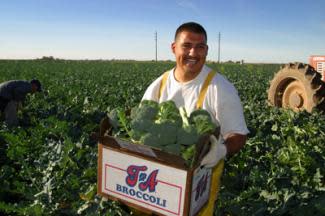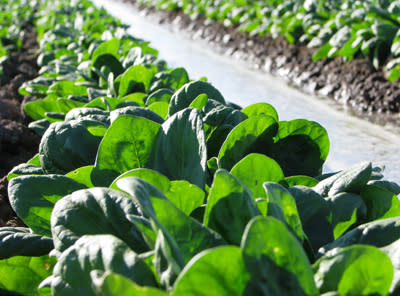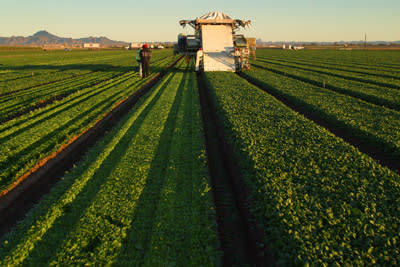Agritourism
 Because most people think of Arizona as a big, dusty desert, they are surprised to learn that agriculture is Yuma County's number one industry - and that Yuma is the winter vegetable capital of the world.
Because most people think of Arizona as a big, dusty desert, they are surprised to learn that agriculture is Yuma County's number one industry - and that Yuma is the winter vegetable capital of the world.
The agriculture industry in Yuma County represents an annual gross economic return of $3.2 billion, or more than one-third of Arizona's annual total of $9.2 billion.
Several things account for that amazing total: Plentiful sunshine, rich soil, ample labor, and high-quality irrigation water.
 With mild winters, little danger of hard frost, and more than 350 days of sunshine a year, Yuma County enjoys the longest growing season in the country. And while the winter is notable for the emerald and ruby patchwork formed by vast vegetable fields, something is either growing or happening in Yuma county fields even during the hottest months of the year.
With mild winters, little danger of hard frost, and more than 350 days of sunshine a year, Yuma County enjoys the longest growing season in the country. And while the winter is notable for the emerald and ruby patchwork formed by vast vegetable fields, something is either growing or happening in Yuma county fields even during the hottest months of the year.
One reason is that those fields - sediments deposited by the Colorado River over millions of years - have some of the most fertile soil in the country.
But with less than three inches of rainfall annually, water was the missing component, though the mighty Colorado flowed nearby. The Bureau of Reclamation's first big water project in the West gave nature a hand, with the construction of the first dam on Colorado and completion of the Yuma Siphon - delivering water through a huge tunnel built under the riverbed - in 1912, the same year Arizona became a state.
Now, of the 230,000 acres of land utilized for agriculture in Yuma County, 100 percent are irrigated with Colorado River water delivered by one of the county's seven irrigation districts. Every single field in the county is also laser-leveled and graded using GPS technology, making Yuma's irrigation network one of the most efficient in the world.
All this has made Yuma County first in the state - and THIRD IN THE NATION - for vegetable production. About 90 percent of all the leafy vegetables grown in the U.S. from November through March are grown in and around the Yuma area.
To put this in perspective, the Yuma area is home to nine salad plants that produce bagged lettuce and salad mixes. During peak production months, each of those plants processes more than two million pounds of lettuce per day.
 There are also 23 cooling plants in the Yuma area, where powerful refrigeration units bring truck-sized loads of vegetables from the field to shipping temperatures in less than half an hour. Crops harvested here in the morning can be in Phoenix by afternoon and on the East Coast in three to four days. (Field note: Lettuce sold by the head is usually field-packed into cardboard boxes, that are bound for salad plants and are harvested into blue plastic bins.)
There are also 23 cooling plants in the Yuma area, where powerful refrigeration units bring truck-sized loads of vegetables from the field to shipping temperatures in less than half an hour. Crops harvested here in the morning can be in Phoenix by afternoon and on the East Coast in three to four days. (Field note: Lettuce sold by the head is usually field-packed into cardboard boxes, that are bound for salad plants and are harvested into blue plastic bins.)
But lettuce is just part of the story: More than 175 different crops are grown in the Yuma area, including many grown to seed here because of our perfect growing conditions. For example, Yuma County ranks number one in Arizona for lemon, tangelo, and tangerine production, and for watermelons and cantaloupes; a local cattle company usually has more than 120,000 head of beef cows on its lot.
 There also are more than 40,000 acres of wheat grown in this region. Desert durum comprises about 95 percent of Arizona's wheat crop, with two-thirds of that exported -- mainly to Italy for use in making premium pasta. Yuma growers also grow kosher wheat to be used by Orthodox Jews to bake matzo (or matzoh), the unleavened bread wafers that are eaten at Passover. Because the rules for kosher production include that the wheat does not receive moisture immediately before harvest, Yuma's desert conditions and controlled irrigation make it a perfect spot to grow this specialty crop.
There also are more than 40,000 acres of wheat grown in this region. Desert durum comprises about 95 percent of Arizona's wheat crop, with two-thirds of that exported -- mainly to Italy for use in making premium pasta. Yuma growers also grow kosher wheat to be used by Orthodox Jews to bake matzo (or matzoh), the unleavened bread wafers that are eaten at Passover. Because the rules for kosher production include that the wheat does not receive moisture immediately before harvest, Yuma's desert conditions and controlled irrigation make it a perfect spot to grow this specialty crop.
Dates are another local crop with Biblical roots. Date production in the Yuma area now totals about 10 million pounds a year, a $30 to 35 million dollar industry that employs more than 2,000 people annually.
 The oldest known tree crop cultivated by humans, dates have been a key food source for more than 6,000 years. Because of a disease outbreak in Morocco, eleven Medjool offshoots were brought to the United States in 1927. To be sure they were disease-free, the trees were quarantined in Nevada and later transplanted to California, and in 1944, offshoots of the original trees were brought to Bard Valley near Yuma.
The oldest known tree crop cultivated by humans, dates have been a key food source for more than 6,000 years. Because of a disease outbreak in Morocco, eleven Medjool offshoots were brought to the United States in 1927. To be sure they were disease-free, the trees were quarantined in Nevada and later transplanted to California, and in 1944, offshoots of the original trees were brought to Bard Valley near Yuma.
Thanks to ideal soil and weather, the area around Yuma and Bard is now the world's largest producer of premium-quality Medjools. Dates are harvested from the end of August through the first weeks of October. Each date palm must be climbed approximately 16-18 times a year to carry out hand operations necessary to ensure a good crop, including pollination, thinning, separating strands of fruit with metal rings to help the air circulate, and finally, bagging the date bunches.
Dates are high in fiber, potassium, and anti-oxidants and contain no fat. They are an organic product, as no pesticides or chemicals are used on the trees or the dates. Many date confections are made locally, along with a local favorite: Dates shakes, or milkshakes made with ice cream and dates.
Agriculture
Yuma’s reputation as a worldwide leader in agriculture is growing, and Visit Yuma wants visitors to know about what makes the farmers and farmland around Yuma so special. Abundant harvests of vegetables, citrus, and melons feed our nation—not necessarily the picture visitors might have...
Read More


